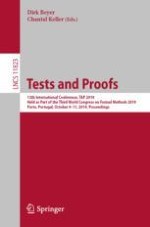2019 | Book
Tests and Proofs
13th International Conference, TAP 2019, Held as Part of the Third World Congress on Formal Methods 2019, Porto, Portugal, October 9–11, 2019, Proceedings
Editors: Dirk Beyer, Chantal Keller
Publisher: Springer International Publishing
Book Series : Lecture Notes in Computer Science


